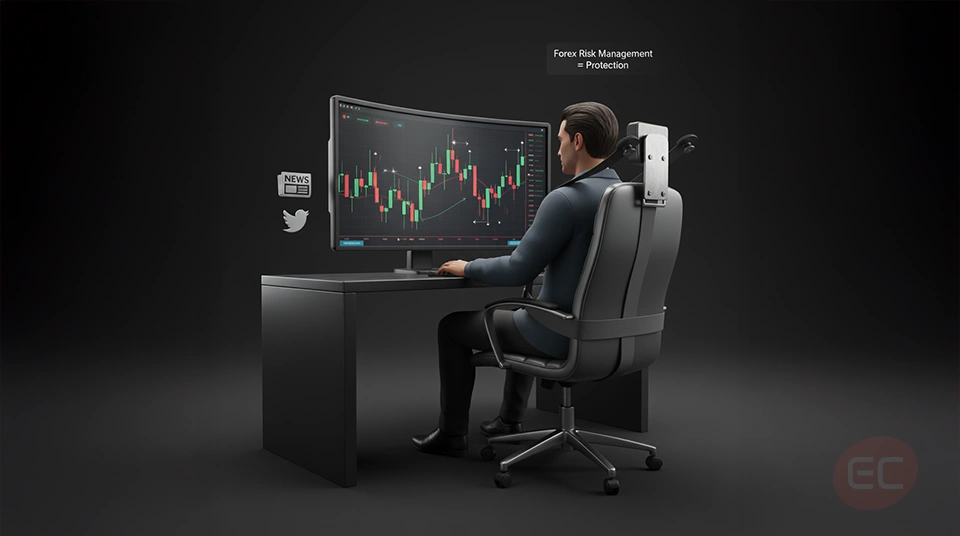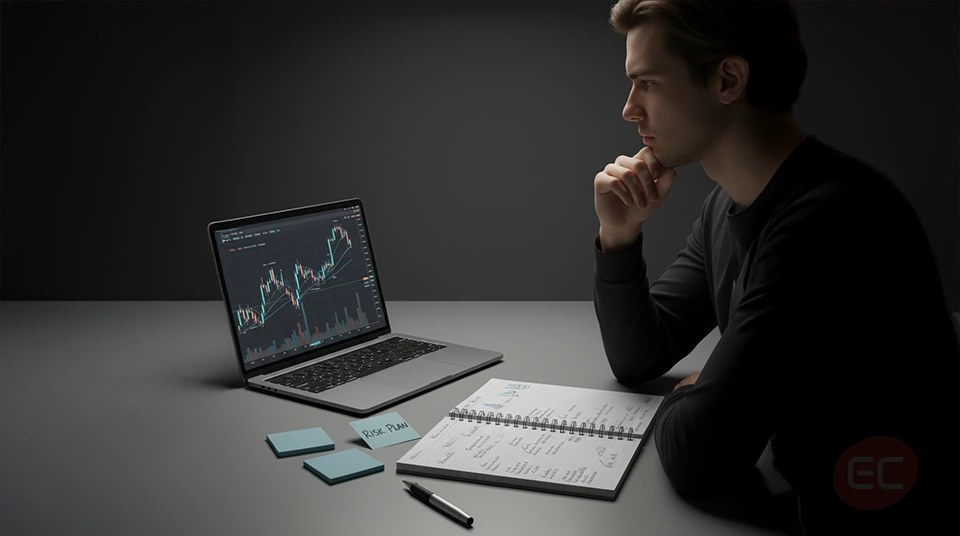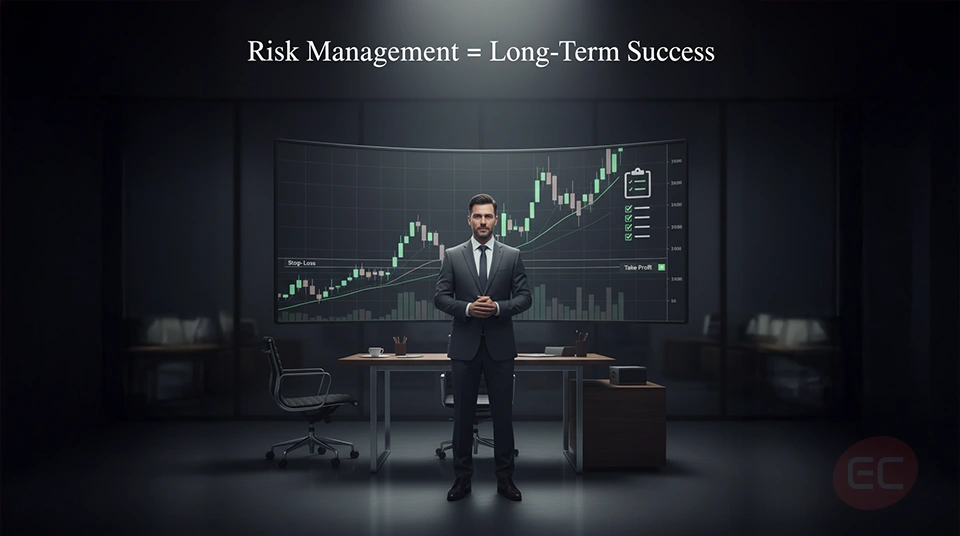Understanding Forex Risk Management
Are you new to trading and starting out a new path in the exciting world of forex? If so, then here’s one concept you absolutely need to master: forex risk management. But what exactly is forex trading risk management and trading risk control. More importantly, why is it so crucial to the success of your trading journey? Whether it's about making consistent profits or simply about protecting your trading account, mastering forex risk management in trading is essential to your success. So let’s break it down together!
- What is Forex Risk Management?
- Why is Forex Risk Management so important?
- How does Forex Risk Management work?
- How to build your own Forex Risk Management Strategy:
- Are you mastering your Forex Risk Management?
- Next Steps: How to put Forex Risk Management into action
- Conclusion: The Power of Forex Risk Management
What is Forex Risk Management?

At the very core, forex risk management is essentially the strategies and practices that traders use to control their risk of losses in the foreign exchange market. Not only is it about protecting your account from a bad trade, it’s also about staying in the game and staying consistent for long enough to actually become successful. You can think of it like wearing a seatbelt while driving, you hope you don’t need it, but if something goes wrong, it's there to protect you. Forex risk management is the exact same concept of wearing your seatbelt. In the fast paced world of forex, where currencies can move in an instant due to economic news, political changes and many other factors, having a strong forex risk management strategy is an absolute must and can make the difference between blowing your account and building a constant stream of profits through forex.
Why is Forex Risk Management so important?
Without proper risk management in trading, you’re essentially getting on a rollercoaster with no safety harness! Many beginner traders make the mistake of jumping in head first with high hopes of making fast profits, but without a clear understanding of risk management in trading, even the best and most experienced traders can fail. Here are a few crucial reasons why trading risk management is so important to the success of your account:
1) A strong forex risk management strategy can preserve your capital.
2) Trading risk management reduces emotional stress. When you’re not panicking about a certain trade and when you’re not acting impulsively, you’re essentially making better trading decisions.
3) Risk management in trading can improve your long term success. Consistency is key, so a proper trading risk control can give you an edge.
How does Forex Risk Management work?
You might be wondering, how does it work exactly? Let’s explore some of the key elements of forex risk management:
1) Position Sizing:
Position sizing determines how much of your capital you can afford to risk on each trade. A common rule that many forex traders make is the 1-2% rule. In other words, you should never risk more than 2% of your account on a single trade. If you can follow this rule, you can control your account.
For example:
Assuming your account has $1000, a 2% risk means that you shouldn’t lose more than $20 on a single trade.
2) Stop Loss Orders
A stop loss is a predefined point where you decide to exit a trade in order to avoid losses. This is an absolutely crucial step in trading risk control. So when you’re trading forex, ask yourself if you’ve set a stop loss on every trade. If you haven’t, your account may be at risk of damage.
3) Take Profit Orders
In the same way that you need to know when to exit a trade to avoid further losses, it’s equally as important to understand when to take profits. A take profit order can help automate this process to lock in your gains.
Here are a few Common Mistakes in Forex Risk Management:
Let’s be honest, mistakes are common, and they’re part of the learning process. But some mistakes can be catastrophic if repeated! With that in mind, let’s go over a few common mistakes that beginner traders make, so you hopefully don’t make the same mistakes.
Mistake number 1: Overleveraging
As we’ve explored throughout these courses, leverage can be a double edged sword. As much as it can amplify your gains, it can also lead to significant losses, and managing leverage effectively is crucial to the safety of your trading account. Leverage is an essential part of your forex risk management strategy.
Mistake number 2: Ignoring your trading plan
Trading without a plan is kind of like sailing without a compass. You’re essentially going into it blind and hoping for the best! Your risk management in trading should be written down and followed consistently.
Trading without a plan is kind of like sailing without a compass. You’re essentially going into it blind and hoping for the best! Your risk management in trading should be written down and followed consistently.
Mistake number 3: Chasing losses
Have you ever placed a bigger trade right after losing one? In the hopes to ‘make it back’? That’s a common mistake that many new traders make and can be detrimental to your account! A proper trading risk control can help you avoid emotional based trading decisions and can help keep you focused on the bigger picture.
How to build your own Forex Risk Management Strategy:

How to develop your own forex risk management system? Here are a few actionable steps you can start with:
- Define your risk tolerance: this may be the most important part of your forex risk management strategy. Are you a conservative trader, or more of a risk taker? Know your style, your preference, and tailor your strategy accordingly.
- Use a risk to reward ratio: aim for trades where your potential rewards can outweigh your potential risks. For example, a 1:2 or 1:3 risk to reward ratio is ideal and an effective solution for trading risk management.
- Track your trades: note down your entry, exit, stop loss, take profit and outcome. Review your trades regularly, this will eventually refine your forex risk management over time.
- Backtest your strategy: Before going live, make sure to test your strategy on historical data, this builds confidence and can help identify flaws in your trading risk control.
Are you mastering your Forex Risk Management?
Before starting a new trade, ask yourself the following questions:
1) Do I have a risk management plan written down?
2) Am I using stop loss and take profit orders?
3) Am I calculating my position size before every trade?
4) Am I trading based on emotion or based on calculated decisions?
How does technology help with Forex Risk Management?
Modern tools can tremendously help with your forex risk management. Here are a few tools you should be using to help with your trading risk management in trading.
Risk management calculators: these calculators can help you to quickly and effectively calculate your position size and lot size based on your account size and risk percentage.
Trading bots and expert advisors (EAs): Automated systems can allow you to follow your trading risk control rules without the interference of emotion based trading.
Trading platforms with risk tools: Popular platforms like MetaTrader 4 & MetaTrader 5 offer powerful, built in tools for better risk management in trading.
Next Steps: How to put Forex Risk Management into action
Here’s a simple action plan to help you put trading risk control into action:
1) Review your last 5 trades. Check if you followed a forex risk management strategy, if you haven’t, start on your next trade.
2) Write your personal rules for your trading risk management plan and keep them close to your trading setup, this will allow you to stay on track.
3) Backtest your trading strategy and make adjustments based on your findings.
4) Start with a demo account using strict trading risk control rules.
Conclusion: The Power of Forex Risk Management

Designer Instructions: Create an image of a confident trader standing in front of a large trading screen displaying successful trades and upward-trending forex charts. The atmosphere should convey achievement, clarity, and control — not gambling or chaos. Add subtle elements like checklists, charts with clear stop-loss/take-profit markers, and perhaps a text overlay that reads “Risk Management = Long-Term Success.” The setting can be a modern trading desk or office to emphasize professionalism and discipline.
As you become a more confident trader and step deeper into the world of forex, the most crucial part of any successful trader's strategy is mastering trading risk management. Many beginner traders underestimate the power of proper trading risk management until it’s too late, but with the right mindset and the right discipline, you can avoid these mistakes that can be detrimental to your trading account. So whether you’re working with small capital or whether you’re investing large amounts of money, strong trading risk management should be your absolute top priority! A smart trading risk control allows you to trade with confidence, by removing the impact of emotional based trading decisions. Instead, make logical, informed trading decisions that can protect you from absolutely catastrophic losses.
Developing a strong trading risk control will set you apart in the long run. In time, you’ll start seeing the market differently. It will no longer be a place to ‘gamble’ and ‘hope for the best’, instead, it will become a system where smart risk management in trading will lead to sustainable and consistent success. So what’s next? Start applying everything you’ve learnt in this course. Determine what kind of trader you are, what level of risk tolerance do you have, and what are your long term goals. Make trading risk control second nature, and most importantly, never stop learning! Your journey towards becoming a successful trader starts with mastering one thing: trading risk management.
We hope you enjoyed this course on forex risk management! If you’re new to trading and looking to develop your knowledge further, then keep on reading as we unlock the next trading courses with the EC Markets Academy.